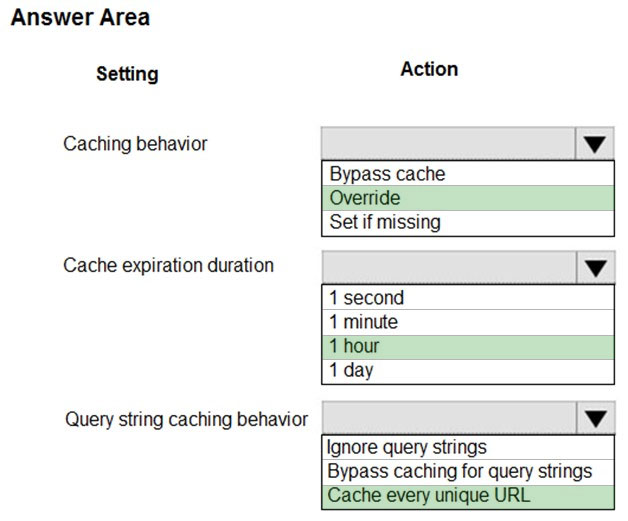

HOTSPOT -
You are developing an Azure App Service hosted ASP.NET Core web app to deliver video-on-demand streaming media. You enable an Azure Content Delivery
Network (CDN) Standard for the web endpoint. Customer videos are downloaded from the web app by using the following example URL: http://www.contoso.com/ content.mp4?quality=1.
All media content must expire from the cache after one hour. Customer videos with varying quality must be delivered to the closest regional point of presence
(POP) node.
You need to configure Azure CDN caching rules.
Which options should you use? To answer, select the appropriate options in the answer area.
NOTE: Each correct selection is worth one point.
Hot Area:

RaviKS
Highly Voted 3 years, 6 months agomlantonis
Highly Voted 3 years, 1 month agomlantonis
3 years, 1 month agomlantonis
3 years, 1 month agoAndySmith
Most Recent 8 months, 2 weeks agoCiupaz
8 months ago1CY1
1 month, 3 weeks agojaf19f
11 months, 1 week agorolling_potato_
1 year, 6 months agoadilkhan
1 year, 5 months agopetitbilly
2 years, 4 months agoAzureDJ
2 years, 4 months agoHimanshuNankani
2 years, 9 months agoMK22
2 years, 11 months agoglam
3 years, 2 months agorakelcoelho
3 years, 3 months agotitombo
3 years, 3 months agoCricketer
3 years, 2 months agoprofesorklaus
3 years, 5 months agoyerisof
3 years, 7 months agoTakumaK
3 years, 1 month agofredrodlima
3 years, 7 months agoTealon
3 years, 7 months agoNyaku
3 years, 7 months ago